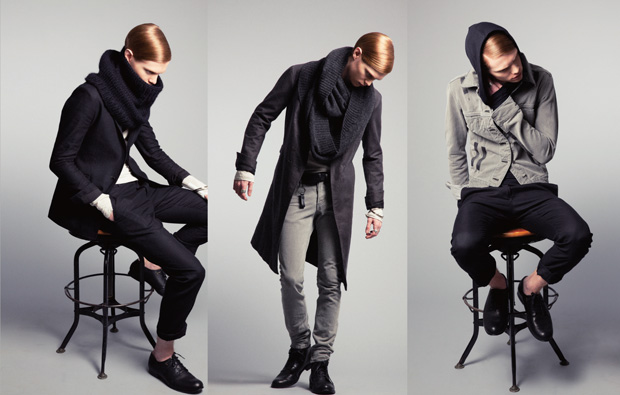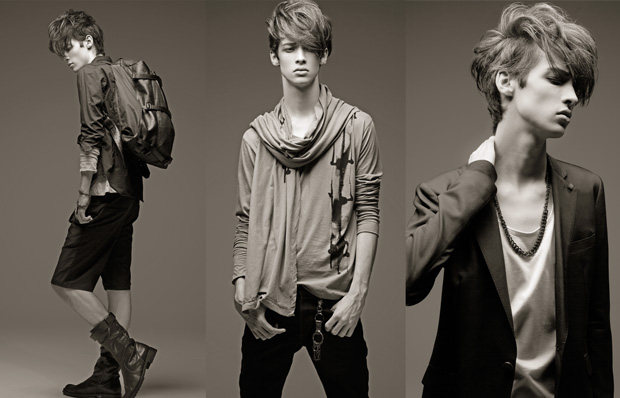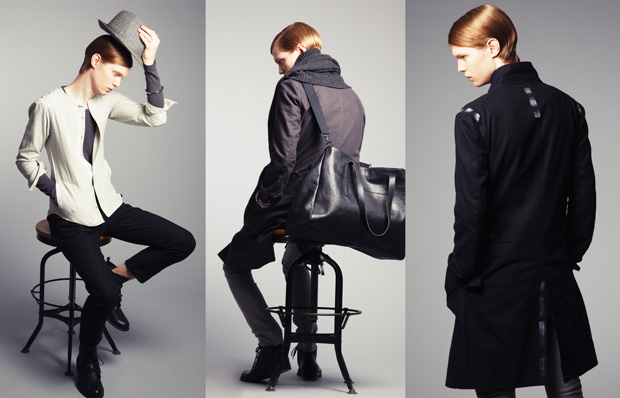by Kelly Wetherille
For most people living in rural communities throughout the West, Tokyo is an unlikely place to end up. Becoming a Tokyo-based fashion designer is even less likely. But in the case of Patrick Stephan, this is just what happened.
Stephan grew up on the tiny French island of Ushant (or Ouessant in French) in the English Channel. This rocky isle has a total landmass of about 15 square kilometers, is home to a population of roughly 900, and marks the furthest point northwest in European France. Stephan recalls that his childhood days were filled with cold, harsh winters followed by warm, beautiful summers. “I like that balance of black and white,” he says of the contrasting weather patterns.
The inhabitants of Ushant for the most part practice a strict brand of Catholicism, and every Sunday the elders on the island still dress in traditional all-black costumes to attend church. As a child, Stephan remembers sitting in his grandparents’ bedroom, wrapping his grandmother’s black silk scarves around bottles to look like dresses, and cutting up his grandfather’s sweaters before fashioning them into other garments. “The style I like is very androgynous, and it probably comes from that [background],” he says. “I like to think I get inspiration from where I’m from—it’s very romantic, delicate, sensitive, but at the same time hard and rugged.”
Stephan left Ushant when he was about 15 years old and took his dreams to Paris. He studied fashion design for three years at ESMOD, winning first prize amongst his classmates for his graduation collection. The theme of his line was ‘My Grandparents.’ His academic success led to a job at the fashion house of Thierry Mugler, where he worked on the label’s first haute couture collection in the early 90s. At this time Stephan had the opportunity to work with and learn from the famous corsetiere Mister Pearl, who is routinely hired by major fashion houses and celebrities (including Dita Von Teese) to create custom, handmade corsets for them. Pearl, who believes in his craft so much that he dresses in a corset himself every day, made emerald green velvet creations embroidered with black stones for the Thierry Mugler collection. Stephan was struck by the intricacy and detail in his work.
In the mid-90s, Stephan spent about two years working in the atelier of Francois Metreau, helping with the design and production of leather garments for houses such as Chanel, Balenciaga and Jean Paul Gaultier. During this time he met John Galliano, and ended up going with Galliano when he took over the reins at Christian Dior. Stephan’s work at Dior further cemented in him his love of fashion and the art that goes into creating it. “I felt the people working in the atelier [at Dior] were really the people who could create the magic,” he says.
One day in 1998 Stephan happened upon a Shiseido exhibition at the Musée des Arts Décoratifs. He was fascinated by the photos and advertisements created by art director Serge Lutens, finding them beautifully minimal and geometric, with art deco influences. “I loved the dramatic contrast of white skin against a black background, and matte versus shiny,” Stephan says. In fact, he loved the exhibition so much that he returned for a second visit shortly after. It was then that he knew he had to make his way to Japan.
After a brief visit during a summer holiday, Stephan jumped at a chance to drop everything and move to Japan in August 1999. He got a job teaching fashion design at the Osaka branch of his alma mater, originally replacing a teacher who was on maternity leave. He stayed with the school for two years before moving to Tokyo to launch his own label.
Stephan’s line started small, with a 20-piece, all-black women’s collection done in natural fabrics such as wool jersey, cotton tulle and leather. The response was better than expected, and the collection was picked up by major retailers such as United Arrows. With the presentation of his second season came even more success: the upscale boutique chain Restir offered to sponsor the collection, a proposal of which most young designers can only dream. Stephan worked with Restir for a few seasons, but eventually began to outgrow the partnership and started looking for a new challenge.
Stephan secured a new investor in 2007 and continued producing his women’s line each season. For 2009 he made the shift to menswear, but he says that many of his female customers stuck with him and continue to buy his clothes. “The look is androgynous, mannish. It appeals to both men and women,” he says.
Stephan’s entire collection, including bags and shoes, is made in Japan, and he works with traditional artisans and factories wherever possible. Japanese influences that can be seen in his clothes include prints that are reminiscent of sumi-e brush paintings, and mesh scarves made at a very old atelier outside of Tokyo. Stephan thinks it is his duty to support these traditional artisans before they disappear completely. “If I can help, I will be really proud, really happy,” he says.
Throughout his career, Stephan’s major influences have remained the same, meaning his collections have a timeless, cohesive feel to them. “I don’t want to use too strong a theme each season,” he says, preferring instead to continue building on the same ideas and inspiration each year. He still maintains his heritage from Ushant as his major influence, and couples this with the contrast of delicate with tough that he learned from working with Mister Pearl and Francois Metreau. He prefers to work almost exclusively with natural textiles, and tries to project a bit of himself into his designs, making clothes for what he describes as a ‘sensitive man.’
In the coming years, Stephan hopes to continue growing his brand by projecting a French name with the idea of ‘made in Japan,’ resisting the temptation to have his products manufactured elsewhere, despite whatever costs this may save. “You can find a kind of perfection here,” he says of Japan. “That’s what I want to spread [to other countries].” But as far as where his own head lies, Stephan isn’t so sure. In fact, he plans to move back to France later this year, although Tokyo will remain his professional base and he will travel back here often for work. “I like to get a point of view from the outside,” he says, noting that he has always liked the unique perspective he gets from being a foreigner in Tokyo. After over a decade of being away from his home country, it’s likely that he’ll now have a ‘foreign’ perspective when he returns there as well.
Patrick Stephan’s spring 2010 collection is in stores now and can be found at Isetan Men’s, Midwest in Shibuya, American Rag Cie in Aoyama, and other shops throughout Tokyo. The autumn collection will be available from August. For more information on shops that carry the line both in Japan and overseas, visit www.patrick-stephan.com.











